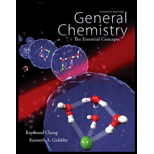
(a)
Interpretation:
The complete balanced equation for the dissolution of gold in aqua regia has to be found and the purpose of the addition of hydrochloric acid to the reaction mixture should be explained.
Concept Introduction:
Dissolution of gold in aqua regia: Aqua regia is the mixture of
A chemical equation is the figurative representation of chemical reaction. In a chemical equation the reactants are in the left side and the products are in the right side. A balanced chemical equation serves as an easy tool for understanding a chemical reaction.
(b)
Interpretation:
The complete balanced equation for the dissolution of gold in aqua regia has to be found and the purpose of the addition of hydrochloric acid to the reaction mixture should be explained.
Concept Introduction:
Dissolution of gold in aqua regia: Aqua regia is the mixture of
A chemical equation is the figurative representation of chemical reaction. In a chemical equation the reactants are in the left side and the products are in the right side. A balanced chemical equation serves as an easy tool for understanding a chemical reaction.
Want to see the full answer?
Check out a sample textbook solution
Chapter 19 Solutions
Package: General Chemistry with Connect 2-year Access Card
 ChemistryChemistryISBN:9781305957404Author:Steven S. Zumdahl, Susan A. Zumdahl, Donald J. DeCostePublisher:Cengage Learning
ChemistryChemistryISBN:9781305957404Author:Steven S. Zumdahl, Susan A. Zumdahl, Donald J. DeCostePublisher:Cengage Learning ChemistryChemistryISBN:9781259911156Author:Raymond Chang Dr., Jason Overby ProfessorPublisher:McGraw-Hill Education
ChemistryChemistryISBN:9781259911156Author:Raymond Chang Dr., Jason Overby ProfessorPublisher:McGraw-Hill Education Principles of Instrumental AnalysisChemistryISBN:9781305577213Author:Douglas A. Skoog, F. James Holler, Stanley R. CrouchPublisher:Cengage Learning
Principles of Instrumental AnalysisChemistryISBN:9781305577213Author:Douglas A. Skoog, F. James Holler, Stanley R. CrouchPublisher:Cengage Learning Organic ChemistryChemistryISBN:9780078021558Author:Janice Gorzynski Smith Dr.Publisher:McGraw-Hill Education
Organic ChemistryChemistryISBN:9780078021558Author:Janice Gorzynski Smith Dr.Publisher:McGraw-Hill Education Chemistry: Principles and ReactionsChemistryISBN:9781305079373Author:William L. Masterton, Cecile N. HurleyPublisher:Cengage Learning
Chemistry: Principles and ReactionsChemistryISBN:9781305079373Author:William L. Masterton, Cecile N. HurleyPublisher:Cengage Learning Elementary Principles of Chemical Processes, Bind...ChemistryISBN:9781118431221Author:Richard M. Felder, Ronald W. Rousseau, Lisa G. BullardPublisher:WILEY
Elementary Principles of Chemical Processes, Bind...ChemistryISBN:9781118431221Author:Richard M. Felder, Ronald W. Rousseau, Lisa G. BullardPublisher:WILEY





